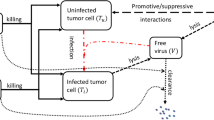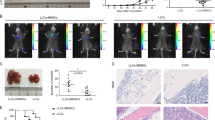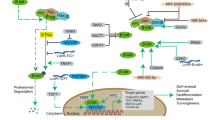Abstract
Most advanced solid tumors metastasize to different organs. However, no gene therapy effective for multiple tumors has yet been developed. Since a unique characteristic of bone marrow-derived mesenchymal stem cells (MSCs) is that they migrate to tumor tissues, we wanted to determine whether MSCs could serve as a vehicle of gene therapy for targeting multiple tumors. First, we confirmed that mouse MSCs preferentially migrate to multiple tumors of the lung in the Colon-26 (C-26) lung metastasis model. Next, MSCs were efficiently transduced with NK4, an antagonist of hepatocyte growth factor (HGF), by an adenoviral vector with an RGD motif. MSCs expressing NK4 (NK4-MSCs) strongly inhibited development of lung metastases in the C-26 lung metastasis model after systemic administration via a tail vein. Treatment with NK4-MSCs significantly prolonged survival of the C-26-tumor-bearing mice by inhibiting tumor-associated angiogenesis and lymphangiogenesis and inducing apoptosis of the tumor cells. MSC-based gene therapy did not induce the severe adverse effects induced by conventional adenoviral vectors. These results indicate that MSCs can serve as a vehicle of gene therapy for targeting multiple lung metastatic tumors.
This is a preview of subscription content, access via your institution
Access options
Subscribe to this journal
Receive 12 print issues and online access
$259.00 per year
only $21.58 per issue
Buy this article
- Purchase on Springer Link
- Instant access to full article PDF
Prices may be subject to local taxes which are calculated during checkout







Similar content being viewed by others
References
Dean M, Fojo T, Bates S . Tumour stem cells and drug resistance. Nat Rev Cancer 2005; 5: 275–284.
Sawyers C . Targeted cancer therapy. Nature 2004; 432: 294–297.
Mocellin S, Mandruzzato S, Bronte V, Lise M, Nitti D . Part I: vaccines for solid tumours. Lancet Oncol 2005; 5: 681–689.
Seth P . Vector-mediated cancer gene therapy: an overview. Cancer Biol Ther 2005; 4: 512–517.
Gregory CA, Prockop DJ, Spees JL . Non-hematopoietic bone marrow stem cells: molecular control of expansion and differentiation. Exp Cell Res 2005; 306: 330–335.
Gafni Y, Turgeman G, Liebergal M, Pelled G, Gazit Z, Gazit D . Stem cells as vehicles for orthopedic gene therapy. Gene Ther 2004; 11: 417–426.
Studeny M, Marini FC, Dembinski JL, Zompetta C, Cabreira-Hansen M, Bekele BN et al. Mesenchymal stem cells: potential precursors for tumor stroma and targeted-delivery vehicles for anticancer agents. J Natl Cancer Inst 2004; 96: 1593–1603.
Nakamura K, Ito Y, Kawano Y, Kurozumi K, Kobune M, Tsuda H et al. Antitumor effect of genetically engineered mesenchymal stem cells in a rat glioma model. Gene Ther 2004; 11: 1155–1164.
Nakamizo A, Maruni F, Amano T, Khan A, Studeny M, Gumin J et al. Human bone marrow-derived mesenchymal stem cells in the treatment of gliomas. Cancer Res 2005; 65: 3307–3318.
Lee K, Majumdar MK, Buyaner D, Hendricks JK, Pittenger MF, Mosca JD . Human mesenchymal stem cells maintain transgene expression during expansion and differentiation. Mol Ther 2001; 3: 857–866.
Totsugawa T, Kobayashi N, Okitsu T, Noguchi H, Watanabe T, Matsumura T et al. Lentiviral transfer of the LacZ gene into human endothelial cells and human bone marrow mesenchymal stem cells. Cell Transplant 2002; 11: 481–488.
Mizuguchi H, Sasaki T, Kawabata K, Sakurai F, Hayakawa T . Fiber-modified adenovirus vectors mediate efficient gene transfer into undifferentiated and adipogenic-differentiated human mesenchymal stem cells. Biochem Biophys Res Commun 2005; 332: 1101–1106.
Montesano R, Matsumoto K, Nakamura T, Orci L . Identification of a fibroblast-derived epithelial morphogen as hepatocyte growth factor. Cell 1991; 67: 901–908.
Matsumoto K, Kataoka H, Date K, Nakamura T . Cooperative interaction between alpha- and beta-chain of hepatocyte growth factor on c-Met receptor confers ligand-induced receptor tyrosine phosphorylation and multiple biological responses. J Biol Chem 1998; 273: 22913–22920.
Bellusci S, Moens G, Gaudino G, Comoglio P, Nakamura T, Thiery JP et al. Creation of an hepatocyte growth factor/scatter factor autocrine loop in carcinoma cells induces invasive properties associated with increased tumorigenicity. Oncogene 1994; 9: 1091–1099.
Weidner KM, Hartmann G, Sachs M, Birchmeier W . Properties and function of scatter factor/hepatocyte growth factor and its receptor c-Met. Am J Respir Cell Mol Biol 1993; 8: 229–237.
Cao R, Bjorndahl MA, Gallego MI, Chen S, Religa P, Hansen AJ et al. Hepatocyte growth factor is a lymphangiogenic factor with an indirect mechanism of action. Blood 2006; 107: 3531–3536.
Maulik G, Shrikhande A, Kijima T, Ma PC, Morrison PT, Salgia R . Role of the hepatocyte growth factor receptor, c-Met, in oncogenesis and potential for therapeutic inhibition. Cytokine Growth Factor Rev 2002; 13: 41–59.
Date K, Matsumoto K, Kuba K, Shimura H, Tanaka M, Nakamura T . Inhibition of tumor growth and invasion by a four-kringle antagonist (HGF/NK4) for hepatocyte growth factor. Oncogene 1998; 17: 3045–3054.
Kuba K, Matsumoto K, Date K, Shimura H, Tanaka M, Nakamura T . HGF/NK4, a four-kringle antagonist of hepatocyte growth factor, is an angiogenesis inhibitor that suppresses tumor growth and metastasis in mice. Cancer Res 2000; 60: 6737–6743.
Maemondo M, Narumi K, Saijo Y, Usui K, Tahara M, Tazawa R et al. Targeting angiogenesis and HGF function using an adenoviral vector expressing the HGF antogonist NK4 for cancer therapy. Mol Ther 2002; 5: 177–185.
Mazzone M, Basilico C, Cacassa S, Pennacchietti S, Risio M, Naldini L et al. An uncleavable form of pro-scatter factor suppresses tumor growth and dissemination in mice. J Clin Invest 2004; 114: 1418–1432.
Studeny M, Marini FC, Champlin RE, Zompetta C, Fidler IJ, Andreeff M . Bone marrow-derived mesenchymal stem cells as vehicles for interferon-beta delivery into tumors. Cancer Res 2002; 62: 3603–3608.
Khakoo AY, Pati S, Anderson SA, Reid W, Elshal MF, Rovira II et al. Human mesenchymal stem cells exert potent antitumorigenic effects in a model of Kaposi's sarcoma. J Exp Med 2006; 203: 1235–1247.
Ji JF, He BP, Dheen ST, Tay SS . Interaction of chemokines and chemokine receptors mediate the migration of mesenchymal stem cells to the impaired site in the brain after hypoglossal nerve injury. Stem Cells 2004; 22: 415–427.
Rojas M, Xu J, Woods CR, Mora AL, Spears W, Roman J et al. Bone marrow-derived mesenchymal stem cells in repair of the injured lung. Am J Respir Cell Mol Biol 2005; 33: 145–152.
Orimo A, Gupta PB, Sgroi DC, Arenzana-Seisdedos F, Delaunay T, Naeem R et al. Stromal fibroblasts present in invasive human breast carcinomas promote tumor growth and angiogenesis through elevated SDF-1/CXCL12 secretion. Cell 2005; 121: 335–348.
Burger JA, Kipps TJ . CXCR4: a key receptor in the crosstalk between tumor cells and their microenvironment. Blood 2006; 107: 1761–1767.
Byrne AM, Bouchier-Hayes DJ, Harmey JH . Angiogenic and cell survival functions of vascular endothelial growth factor (VEGF). J Cell Mol Med 2005; 9: 777–794.
George D . Platelet-derived growth factor receptors: a therapeutic target in solid tumors. Semin Oncol 2001; 28s: 22–33.
Mendelsohn J . The epidermal growth factor receptor as a target for cancer therapy. Endocr Relat Cancer 2001; 8: 3–9.
Yuan A, Chen JJ, Yao PL, Yang PC . The role of interleukin-8 in cancer cells and microenvironment interaction. Front Biosci 2005; 10: 853–865.
Matsumoto K, Nakamura T . NK4 (HGF-antagonist/angiogenesis inhibitor) in cancer biology and therapeutics. Cancer Sci 2003; 94: 321–327.
Nicole R, Bryan K, Melanie C, Simona P, Kris P, Yan Wu et al. Inhibition of VEGFR-3 activation with the antagonistic antibody more potently suppresses lymph node and distant metastases than inactivation of VEGFR-2. Cancer Res 2006; 66: 2650–2657.
Skobe M, Hawighorst T, Jackson DG, Prevo R, Janes L, Velasco P et al. Induction of tumor lymphangiogenesis by VEGF-C promotes breast cancer metastasis. Nat Med 2001; 7: 192–198.
Alitalo K, Carmeliet P . Molecular mechanisms of lymphangiogenesis in health and disease. Cancer Cell 2002; 1: 219–227.
Su JL, Yang PC, Shih JY, Yang CY, Wei LH, Hsieh CY et al. The VEGF-C/Flt-4 axis promotes invasion and metastasis of cancer cells. Cancer Cell 2006; 9: 209–223.
Schagen FH, Ossevoort M, Toes RE, Hoeben RC . Immune responses against adenoviral vectors and their transgene products: a review of strategies for evasion. Crit Rev Oncol Hematol 2004; 50: 51–70.
Matus S, Frank CM, Jennifer LD, Claudia Z, Maria C, Benjamin NB et al. Mesenchymal stem cells: potential precursors for tumor stroma and targeted-delivery vehicles for anticancer agents. J Natl Cancer Inst 2004; 96: 1593–1603.
Acknowledgements
This work was supported in part by the Grant-in-Aid for Scientific Research from the Ministry of Education, Science, Sports, Culture, and Technology of Japan (Grant no. 17790520 and 16390232).
Author information
Authors and Affiliations
Corresponding author
Rights and permissions
About this article
Cite this article
Kanehira, M., Xin, H., Hoshino, K. et al. Targeted delivery of NK4 to multiple lung tumors by bone marrow-derived mesenchymal stem cells. Cancer Gene Ther 14, 894–903 (2007). https://doi.org/10.1038/sj.cgt.7701079
Received:
Revised:
Accepted:
Published:
Issue Date:
DOI: https://doi.org/10.1038/sj.cgt.7701079
Keywords
This article is cited by
-
Mesenchymal stem/stromal cells in cancer therapy
Journal of Hematology & Oncology (2021)
-
Mesenchymal stem cells in cancer progression and anticancer therapeutic resistance
Cancer Cell International (2021)
-
Tumour-associated mesenchymal stem/stromal cells: emerging therapeutic targets
Nature Reviews Drug Discovery (2017)
-
Gene Delivery Approaches for Mesenchymal Stem Cell Therapy: Strategies to Increase Efficiency and Specificity
Stem Cell Reviews and Reports (2017)
-
Activated human mesenchymal stem/stromal cells suppress metastatic features of MDA-MB-231 cells by secreting IFN-β
Cell Death & Disease (2016)



